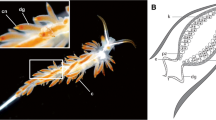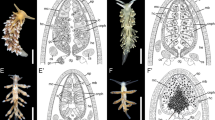Abstract
Nudibranchs (Mollusca, Gastropoda) feeding on tentacles and polyps of Cnidaria thereby ingest both latent and discharged nematocysts (NCs) along with the food mass. In eolid nudibranchs (Opisthobranchia, Aeolidacea), many of the undischarged NCs are transported to terminal cnidosacs in their body appendages (cerata) and incorporated as kleptocnidae for defense. In the present report, the occurrence and fate of NCs in the digestive tracts of eolids is compared with hydrozoan-feeding dendronotacean nudibranchs (Opisthobranchia, Dendronotacea), which may show more basic stages in the evolution of cnidosacs. Tomographic reconstructions of the distal tips of cerata were composed from series of semithin light microscopic sections, utilizing 3D-surface rendering software. Doto acuta (Dendronotacea, Dotidae) does not have cnidosacs; transmission electron micrographs show that the NCs are digested in lysosomes of digestive gland cells. In contrast, species of the genus Hancockia (Dendronotacea, Hancockiidae) have several small cnidosacs in each ceras; they accumulate NCs in the digestive cells, as well as in the cnidosacs. Many of the cnidosacs were found open to the exterior with NCs in the process of expulsion. These and other structural details suggest assigning a function of expelling the NCs to the Hancockia spp. cnidosacs. It is proposed that cnidosacs similar to those of Hancockia spp. provide a clue to understanding how the defensive function of eolid cnidosacs may have evolved.




Similar content being viewed by others
References
Alejandrino A (2007) Phylogeny of Aeolidacea (Gastropoda: Nudibranchia). In: Jordaens K, Van Houtte N, Van Goethem J, Backeljau T (eds) World Congress of Malacology, Antwerp, Belgium, 15 July 2007, abstracts: 198
Burghardt I, Stemmer K, Waegele H (2008) Symbiosis between Symbiodinium (Dinophyceae) and various taxa of Nudibranchia (Mollusca: Gastropoda), with analyses of long-term retention. Org Divers Evol 8:66–76. doi:https://doi.org/10.1016/j.ode.2007.01.001
Day RM, Harris LG (1978) Selection and turnover of coelenterate nematocysts in some aeolid nudibranchs. Veliger 21:104–109
Edmunds M (1966) Protective mechanisms in the Eolidacea (Mollusca: Nudibranchia). J Linn Soc Zool 47:27–71. doi:https://doi.org/10.1111/j.1096-3642.1966.tb00082.x
Glaser OC (1910) The nematocysts of eolids. J Exp Zool 9:117–142. doi:https://doi.org/10.1002/jez.1400090106
Grande C, Templado J, Cervera JL, Zardoya R (2004) Molecular phylogeny of Euthyneura (Mollusca: Gastropoda). Mol Biol Evol 21:303–313. doi:https://doi.org/10.1093/molbev/msh016
Greenwood PG, Mariscal RN (1984a) Immature nematocyst incorporation by the aeolid nudibranch Spurilla neapolitana. Mar Biol (Berl) 80:35–38. doi:https://doi.org/10.1007/BF00393124
Greenwood PG, Mariscal RN (1984b) The utilization of cnidarian nematocysts by aeolid nudibranchs: nematocyst maintenance and release in Spurilla. Tissue Cell 16:719–730. doi:https://doi.org/10.1016/0040-8166(84)90005-3
Grosvenor GH (1903) On the nematocysts of aeolids. Proc R Soc Lond 72:462–486. doi:https://doi.org/10.1098/rspl.1903.0075
Harris LG (1973) Nudibranch associations. In: Cheng TC (ed) Current topics in comparative pathobiology, vol II. Academic Press, New York, pp 213–315
Harris LG (1987) Aeolid nudibranchs as predators and prey. Am Malacol Bull 5:287–292
Herdman WA (1890) Some experiments on feeding fishes with nudibranchs. Nature 42:201–203. doi:https://doi.org/10.1038/042201a0
Kälker H, Schmekel L (1976) Bau und Funktion des Cnidosacks der Aeolidoidea (Gastropoda: Nudibranchia). Zoomorphologie 86:41–60. doi:https://doi.org/10.1007/BF01006712
Klussmann-Kolb A, Wägele H (2005) Opisthobranchia (Mollusca, Gastropoda)-more than just slimy slugs. Shell reduction and its implications on defence and foraging. Front Zool 2:3. doi:https://doi.org/10.1186/1742-9994-2-3
MacFarland FM (1923) The morphology of the nudibranch genus Hancockia. J Morphol 38:65–104. doi:https://doi.org/10.1002/jmor.1050380104
Martin R (2003) Management of nematocysts in the alimentary tract and in cnidosacs of the aeolid nudibranch gastropod Cratena peregrina. Mar Biol (Berl) 143:533–541. doi:https://doi.org/10.1007/s00227-003-1078-8
Martin R, Walther P (2002) Effects of discharging nematocysts when an eolid nudibranch feeds on a hydroid. J Mar Biol Assoc UK 82:455–462. doi:https://doi.org/10.1017/S0025315402005714
Martin R, Hild S, Walther P, Ploss K, Boland W, Tomaschko KH (2007a) Granular chitin in the epidermis of nudibranch molluscs. Biol Bull 213:307–315
Martin R, Tomaschko KH, Walther P (2007b) Protective skin structures in shell-less marine gatropods. Mar Biol (Berl) 150:807–817. doi:https://doi.org/10.1007/s00227-006-0402-5
Miller JA, Byrne M (2000) Ceratal autotomy and regeneration in the aeolid nudibranch Phidiana crassicornis and the role of predators. Invertebr Biol 119:167–176
Morse MP (1971) Biology and life history of the nudibranch mollusc Coryphella stimpsoni (Verrill 1879). Biol Bull 140:84–94. doi:https://doi.org/10.2307/1540028
Rousseau C (1935) Histophysiologie du foie des éolidiens. Étude de leurs xanthelles. Cytologie des cellules nématophages. Arch Anat Micr 31:305–395
Rudman WB (1981) Polyp mimicry in a new species of aeolid nudibranch mollusc. J Zool 193:421–427
Schmekel L, Portmann A (1982) Opisthobranchia des Mittelmeeres. Nudibranchia und Saccoglossa. In: Fauna e Flora del Golfo di Napoli. 40 Monografia della Stazione Zoologica di Napoli. Springer, Berlin, pp 1–410
Schrödl M (1999) Hancockia schoeferti, spec. nov., a new dendronotoidean nudibranch species from central Chile. Spixiana 22:247–254
Streble H (1967) Bau und Bedeutung der Nesselsäcke von Aeolidia papillosa L., der breitwarzigen Fadenschnecke (Gastropoda, Opisthobranchia). Zool Anz 180:356–372
Swofford DL (2002) PAUP*: phylogenetic analysis using parsimony (*and other methods), Version 4b. Sinauer Associates, Sunderland
Thompson TE (1972) Eastern Australian Dendronotoidea (Gastropoda, Opisthobranchia). Zool J Linn Soc 51:63–77. doi:https://doi.org/10.1111/j.1096-3642.1972.tb00773.x
Wägele H, Willan RC (2000) Phylogeny of Nudibranchia. Zool J Linn Soc 130:83–181. doi:https://doi.org/10.1111/j.1096-3642.2000.tb02196.x
Wolter H (1967) Beiträge zur Biologie, Histologie und Sinnesphysiologie (insbesondere der Chemorezeptoren) einiger Nudibranchier (Mollusca, Opisthobranchia) der Nordsee. Z Morphol Oekol Tiere 60:275–337. doi:https://doi.org/10.1007/BF00424637
Wright, TS (1858–1861) On the cnidae or thread-cells of the Eolidae. Proc R Phys Soc Edinburgh, Sessions 1858–1861
Acknowledgments
Yuri Hooker (Lima) helped to collect specimens of Hancockia schoeferti. The fieldwork in Peru was supported by the GeoBioCenter (LMU) and the Deutsche Forschungsgemeinschaft (DFG SCHR 667/4 to MS). Claus Valentin provided excellent working conditions at the Institute of Marine Biology at Giglio. We would like to thank Prof. E. Koenig (Buffalo) for critically reading and revising the manuscript.
Author information
Authors and Affiliations
Corresponding author
Additional information
Communicated by J.P. Grassle.
Electronic supplementary material
Below is the link to the electronic supplementary material.
Phylogenetic relationships of cnidosac bearing nudibranch gastropods
. The morphological data set (47 characters; one hypothetical plesiomorphic group plus 2 pleurobranchoidean taxa as outgroups, and 29 nudibranch taxa) used to reveal the phylogeny of the Nudibranchia by Wägele & Willan (2000) herein was supplemented by Hancockia and reanalyzed (PAUP). All characters were treated as unweighted and unordered; the tree was unrooted. The strict consensus tree of 120 equally parsimonious trees (102 steps) is shown; numbers refer to bootstrap values (<50 not indicated), obtained by a separate analysis (1000 replications, PAUP) with the same settings; a clade of Protaeolidiella and Phyllodesmium (marked in grey) received some bootstrap support but is not represented in the strict consensus tree. Species possessing cnidosacs with kleptocnidae are in bold face; Protaeolidiella has cnidosacs but without containing kleptocnidae. While the monophyly or e.g. Nudibranchia, Anthobranchia, and Doridacea is supported by high bootstrap values (>90), none of the traditional major dexiarchian taxa Arminacea, Dendronotacea and Aeolidacea results monophyletic. The Arminidae from the sister clade to a polytomy composed of members all three groups. The dendronotacean Hancockia (with cnidosacs) and Doto (without cnidosacs) group together, nestling within cnidosac-possessing eolid taxa in the strict consensus tree; however, these relationships are not statistically supported. From this, due to limited taxon and character sampling, very preliminary phylogenetic point of view, the systematic position of Hancockia and the evolution of cnidosacs remain unresolved
Rights and permissions
About this article
Cite this article
Martin, R., Heß, M., Schrödl, M. et al. Cnidosac morphology in dendronotacean and aeolidacean nudibranch molluscs: from expulsion of nematocysts to use in defense?. Mar Biol 156, 261–268 (2009). https://doi.org/10.1007/s00227-008-1080-2
Received:
Accepted:
Published:
Issue Date:
DOI: https://doi.org/10.1007/s00227-008-1080-2




